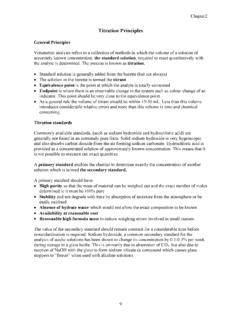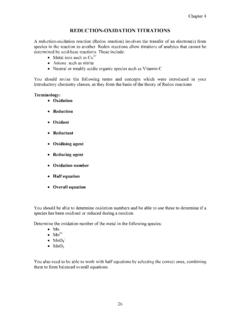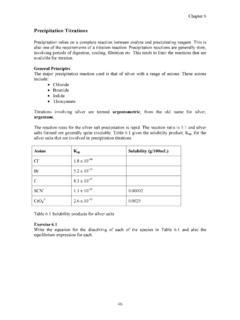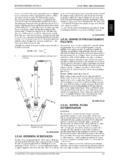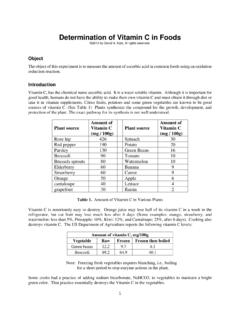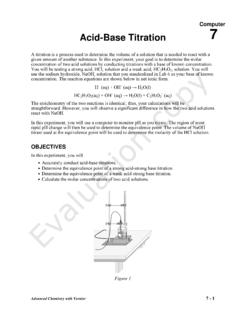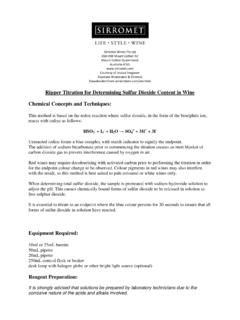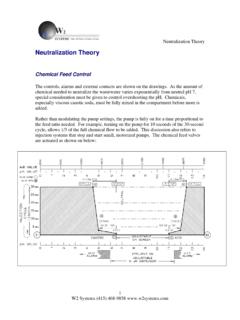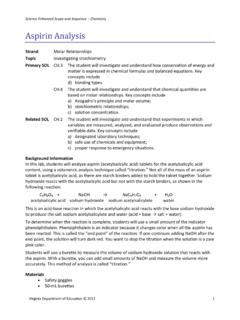Transcription of ACID-BASE TITRATIONS - cffet.net
1 Chapter 3 17 ACID-BASE TITRATIONS The reaction of acid and base involves transfer of a proton from acid to base and is often called a neutralisation reaction. It is important to note that only a few reactions produce a neutral solution due to hydrolysis in the resultant solution. Common titrants A major requirement of an acidic or basic titrant is that the species is a strong acid or base . If a weak acid or base were used to titrate a weak base or weak acid then the equivalence point could not be detected. A strong acid or base enhances the equivalence point making it easier to detect. Common acid titrants include: Hydrochloric acid Nitric acid Sulfuric acid Common base titrants include: Sodium hydroxide Potassium hydroxide Primary standards for standardisation of an acid Sodium carbonate (anhydrous), Na2CO3.
2 Formula weight = 106 Commercially available in very pure state Slightly hygroscopic so should be dried for an hour and allowed to cool in a desiccator before use Weak base which can react with two lots of H+ and so has 2 end-points. At pH CO32- HCO3- At pH HCO3- H2CO3 Titration is always carried out to the second endpoint where there is a noticeable change in pH from pH (of Na2CO3) to pH Indicator should change colour in the acidic region eg methyl orange or methyl red Low relative formula weight which can lead to increased weighing errors. This may be overcome by preparing a large volume and taking aliquots for the titration Borax, Formula weight = Sodium tetraborate is a weak base Reacts with two H+ for complete reaction Has waters of crystallisation which introduce errors Weighing errors are reduced as the borax has a large formula weight Chapter 3 18 Primary standards for standardisation of a base Potassium hydrogen phthalate (KHP) KC8H5O4 Formula weight Organic compound (see Fig )
3 Monoprotic Has high formula weight Non-hygroscopic Water-soluble Available commercially in very pure form Equivalence point is in the basic region therefore an indicator such as phenolphthalein should be used. Fig Structure of potassium hydrogen phthalate Endpoint Detection ACID-BASE TITRATIONS result in a marked change in solution pH at the equivalence point. It is this change that is detected using the appropriate indicator. Away from the equivalence point the pH changes only gradually, but close to the equivalence point it changes rapidly. Note the changes in pH shown in Fig for the titration of mL of HCl with NaOH Fig pH changes during an ACID-BASE titration Chapter 3 19 There is a large pH change in the vicinity of the equivalence point for the addition of a very small volume of titrant.
4 The indicator chosen for the reaction must change colours within the pH range, for Fig a suitable indicator would change colours between pH 4 and 10. Indicators An ACID-BASE indicator is an organic compound which has weak acidic or basic functional groups such as NH2, -COOH, -OH or SO3H. As the solution pH changes from acid to base , the acid form is changed into its conjugate base . These two forms must have distinctly different colours if the compound is to be an indicator. Fig shows the forms of phenolphthalein which is colourless in the acid form and pink in the basic form acid form base form Fig Forms of phenolphthalein It is important to note that the colour change of an indicator is not dependent on the solution being titrated.
5 The indicator changes colour at a particular pH . The indicator chosen for a titration must change colours at the pH of the equivalence point Table Some common ACID-BASE indicators Indicator pH range of Colour Change Colour Change Methyl orange Methyl red Bromothymol Blue Phenol Red Phenolphthalein Thymolphthalein Chapter 3 20 Choosing the correct indicator The pH at equivalence point varies depending on the reaction. It may be neutral, alkaline or acidic even though the products are a salt and water. Strong acid vs Strong base The equivalence point for this reaction is pH 7 as a neutral salt is formed Fig shows the dramatic change in pH at the equivalence point.
6 For the strong acid and strong base this is at pH 7. A suitable indicator would be one that has its colour change range in this region. The salt formed in this reaction is neutral, it does not undergo hydrolysis. Fig Titration of strong acid by strong base Draw a diagram for the titration of a strong base by a strong acid and select a suitable indicator for the titration from Table Strong acid + Strong base Neutral salt + water HCl + NaOH NaCl + H2O Chapter 3 21 The salt formed in the titration is not always neutral. Where a weak acid or base is involved, the salt becomes the conjugate partner ie at equivalence point the solution will contain a weak acid or base and therefore have a pH greater or less than 7 as the salt undergoes hydrolysis with water.
7 Strong acid vs Weak base The equivalence point for this reaction is less than 7 and the indicator chosen must therefore change colour in the acid region. Fig Strong acid titrated with a weak base Note that the equivalence point is below 7 in Fig Draw a diagram for the titration of a weak base with a strong acid and choose a suitable indicator from Table Strong acid + Weak base Acidic Salt + water HCl + NH3 NH4Cl + H2O Chapter 3 22 Strong base vs Weak acid The equivalence point for this reaction is greater than 7 and the indicator must change colour in the alkaline region.
8 Fig Titration of a weak acid by a strong base Note that the equivalence point is above 7 in Fig Draw a diagram representing the change in pH for the titration of a strong base by a weak acid and choose a suitable indicator from those provided in Table Weak acid + Strong base Basic salt + water CH3 COOH + NaOH NaCH3 COO + H2O Chapter 3 23 A weak acid titrated with a weak base (or vice versa) does not exhibit the same dramatic pH change in the vicinity of the equivalence point. There is only an inflection point, which does not allow using an indictor to show the approximate equivalence point The most appropriate indicator for an ACID-BASE titration is one which has its colour change in the vicinity of the equivalence point.
9 Where there is a large pH jump more than one indicator would be satisfactory. When selecting the indicator factors such as the nature of the colour change may also need to be considered. Phenolphthalein has a dramatic colour change, from colourless to bright purple/pink. This makes it easy to recognise. Methyl orange has a colour change of red to fades to orange as the titration proceeds ..this makes the actual colour change difficult to detect. A sharper and more pronounced colour change can be obtained by mixing the indicator solution with a neutral dye. The new solution is known as a screened indicator. The pH at the colour change is not altered, only the colours.
10 For screened methyl orange the colour change is from green (at high pH) through to grey and then to red (at low pH). Universal indicators are mixtures of a number of standard indicators, designed so there is a series of colour changes at intervals across a wide pH range. The commonly encountered formulation contains, phenolphthalein, methyl orange, methyl red and bromothymol blue. The gradual change of colour with pH makes them generally unsuitable for endpoint detection. QUESTIONS Concepts 1. Give three reasons why KHP is an ideal primary standard for alkaline solutions 2. Why is phenolphthalein ideal for the detection of neutral or alkaline endpoint TITRATIONS ?

